Nothing in the cry of cicadas suggests that they are about to die.
~Matsuo Basho
I imagine you are deluged with social media posts and news reports about the spectacle that those of us in this area are living with right now – the emergence of Brood XIX of periodical cicadas. I hesitated adding one more blog about this phenomenon, but, let’s face it, it is pretty astonishing. And, perhaps it will help one of the many people I read about on social media every day that are wondering what that strange whining sound is all about. So, let’s start with that sound (recorded yesterday in front of our house; yu will also hear one of the many Wood Thrush that sing in our woods)…(turn sound up)
–The sound of thousands of male periodical cicadas chorusing in the tree tops
I photographed members of this brood the last time they were above ground in this area back in 2011. My article in this months’ issue of Walter magazine is about the current emergence but has photos from 2011 (due to publication schedules, the current brood had not emerged by my deadline date). The dates of those 2011 photos correspond closely (within a week, with this year being a bit earlier) with this year’s emergence. That is pretty remarkable given the 13-year time difference. Note – we also have a few species of so-called annual cicadas in our area but they are generally larger, green in color, and emerge later in the summer.
Here’s a quick summary of this marvelous event and the life cycle of these amazing creatures. Nymphs spend 13 years underground sucking on nutrients in tree roots. They may be able to tell the passage of time by the seasonality of the trees in terms of sap flow and nutrient differences between winter and summer tree seasons. When the time is right, they dig their way to the surface, often leaving a prepared exit hole and waiting until soil temperatures reach about 64 degrees. They tend to emerge at night and then crawl up a vertical surface to transform into the adult cicada. That process involves splitting the back of the nymphal skin, pulling out and then clinging to something (usually the excuviae they just shed) and pumping fluid into their wings to expand them. This process takes an hour or more. Adults begin to fly the next day (they aren’t great at it) and males start singing in a few days when enough have emerged to “chorus”. Chorusing is usually done high in the trees. This attracts females and mating takes place. She then uses her knife-like ovipositor to slice into twigs and lay her eggs. This causes flagging of the branches, often pruning the tips. Nymphs hatch in about 6 weeks, drop to the ground, dig a couple of feet into the soil and start the cycle all over again.

-Periodical cicada holes showing the high concentration. This photo is of the space between stepping stones in a walkway in downtown Pittsboro. I have seen estimates as high as one million cicadas per a acre during this emergence (click photos to enlarge)
There are seven species of periodical cicadas (all are found only in the Midwest or Eastern North America) – four have 13-year cycles and three have 17-year life cycles. We are pretty sure we have three species of the Brood XIX 13-year cicadas emerging on our property (a brood is an assemblage of periodical cicadas with synchronized emergence over a geographic area) . Our largest is Magicicada tredecim (with an orange abdomen). The two smaller species are similar in size to each other but differ in color – M. tredecassini (small and no orange) and M. tredecula (small with narrow orange stripes). The large species seemed to be the dominant one the first day or two of the emergence. The past couple of days has had a lot more of the two smaller species. Emergence seems to have occurred in patches on our property, with some high concentrations in select areas in the yard one evening and another location the next night. It looks as though they aren’t climbing much higher than 10 or 15 feet into the trees to transform with many at the tips of low branches.
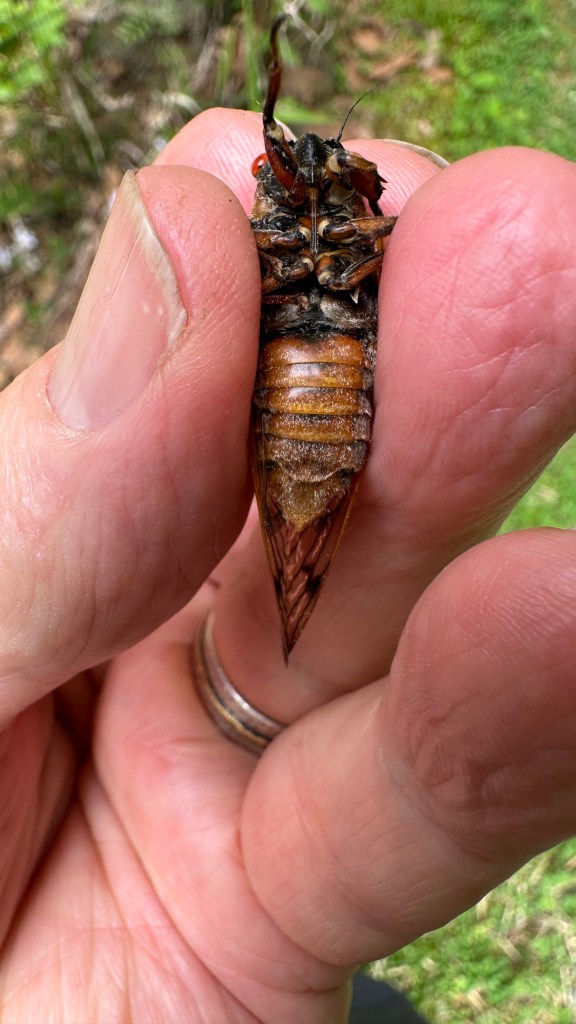
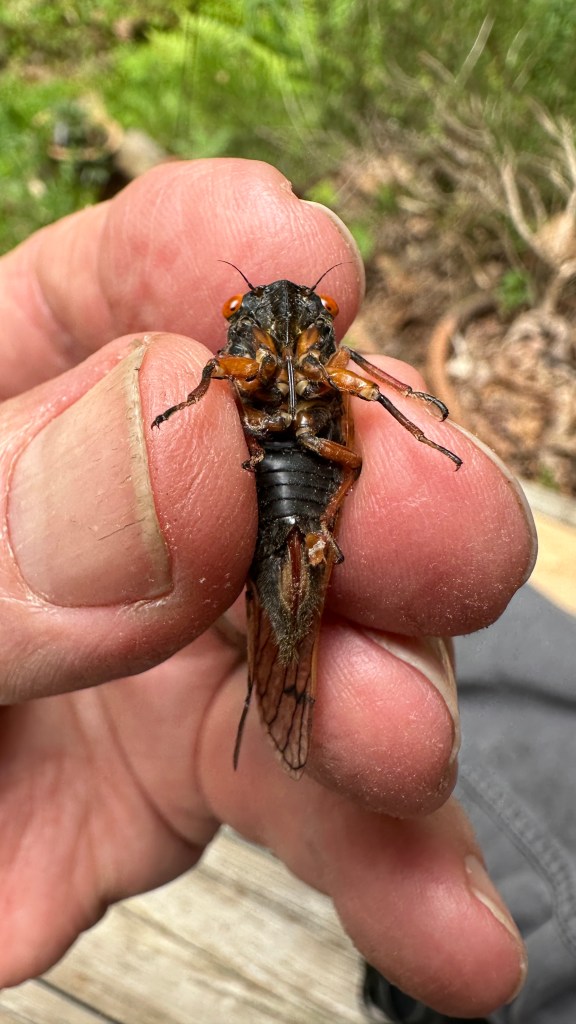
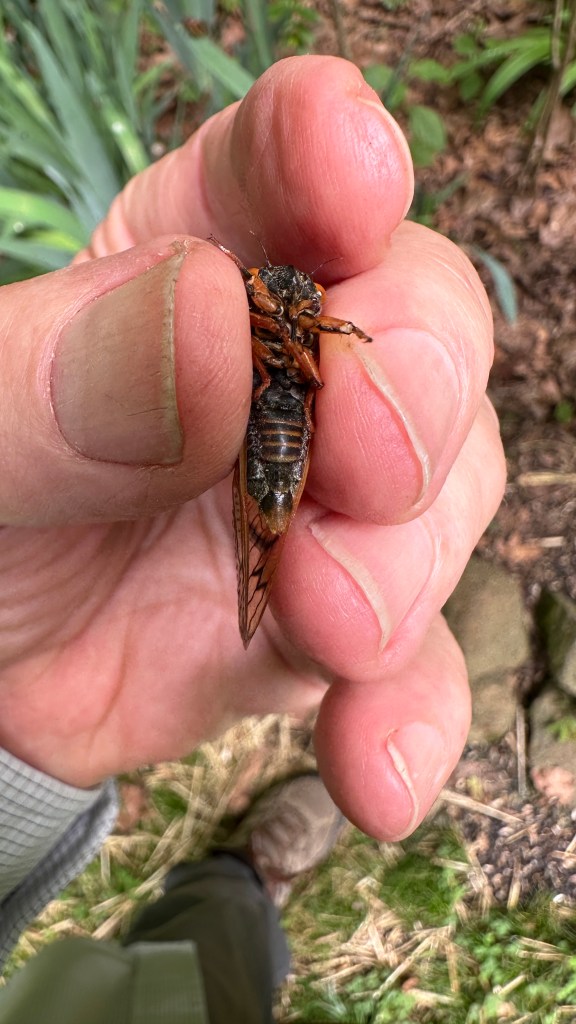
Birds are feasting on them and I have seen Carolina Chickadees, Eastern Bluebirds, and Summer Tanagers all grabbing them. I imagine squirrels, mice, and maybe even deer are dining on these tiny “shellfish wannabes” as well. Nearby friends have posted photos of lizards and snakes with very full bellies so I think the cicadas are on the menu of many local species. I’m still trying to decide if I want to try one (the nymphs supposedly taste nutty when cooked). I’ll let you know if I do.
There are several excellent resources out there if you want to dive deeper into this subject. Cicada Mania and Cicada Safari are two excellent resources as is the University of Connecticut Periodical Cicada website.
Here are a few of the highlights from my cicada wanderings in our yard:
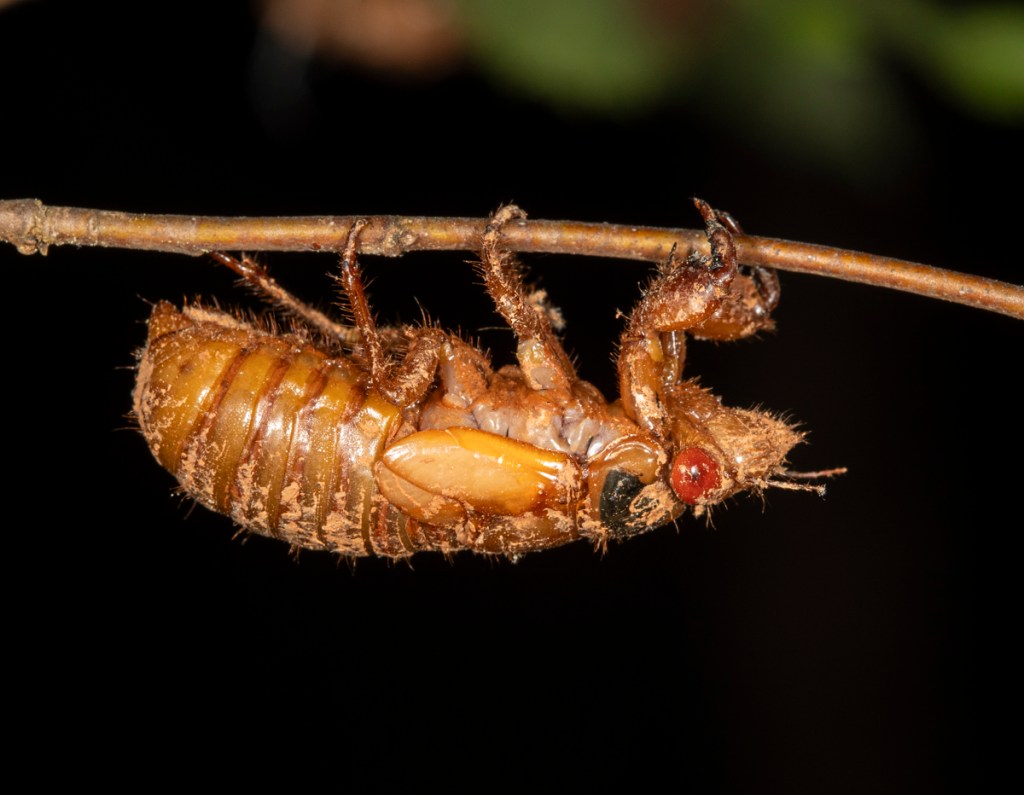

Something you may notice on the exuviae (shed “skins”) of the nymphs are small white “strings”. These are the tracheal tubes, the “pipes” of the respiratory system of the insect. They run throughout the nymphs’ body and are connected to the outside via the spiracles (respiratory openings on the thorax and abdomen of insects). When the nymphs shed their exoskeleton, the tracheal linings are also shed.



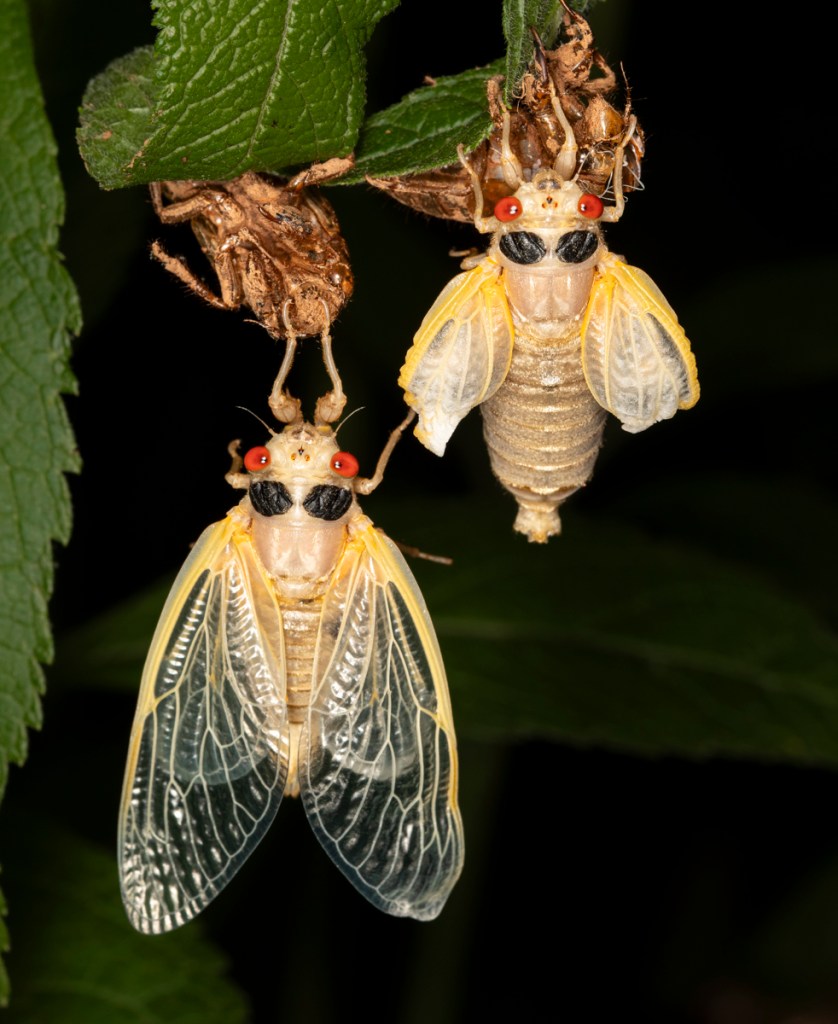
According to one resource I read, the two large black spots you see in freshly emerged periodical cicadas contain pigment that will gradually spread throughout the cicada’s body as it hardens, transforming it from this ghostly white color to the final black form. Some have also speculated that the large spots may deter predators since they resemble large eyes, giving the impression of a much larger creature.

It takes an hour or so for the wings to fully expand. The cicadas will go through a color transformation as well.
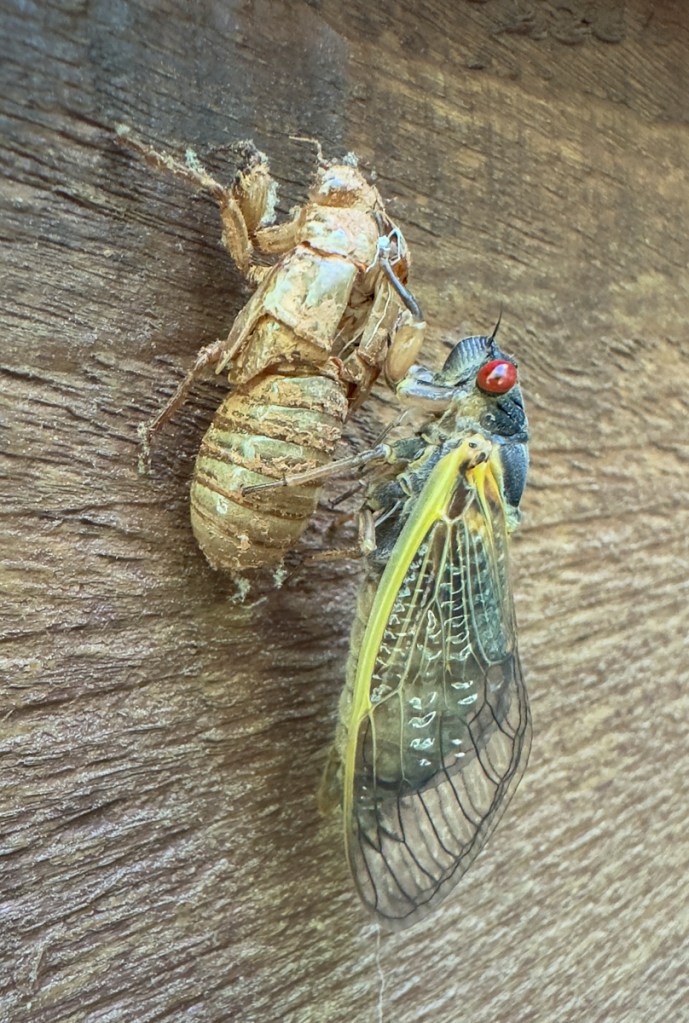
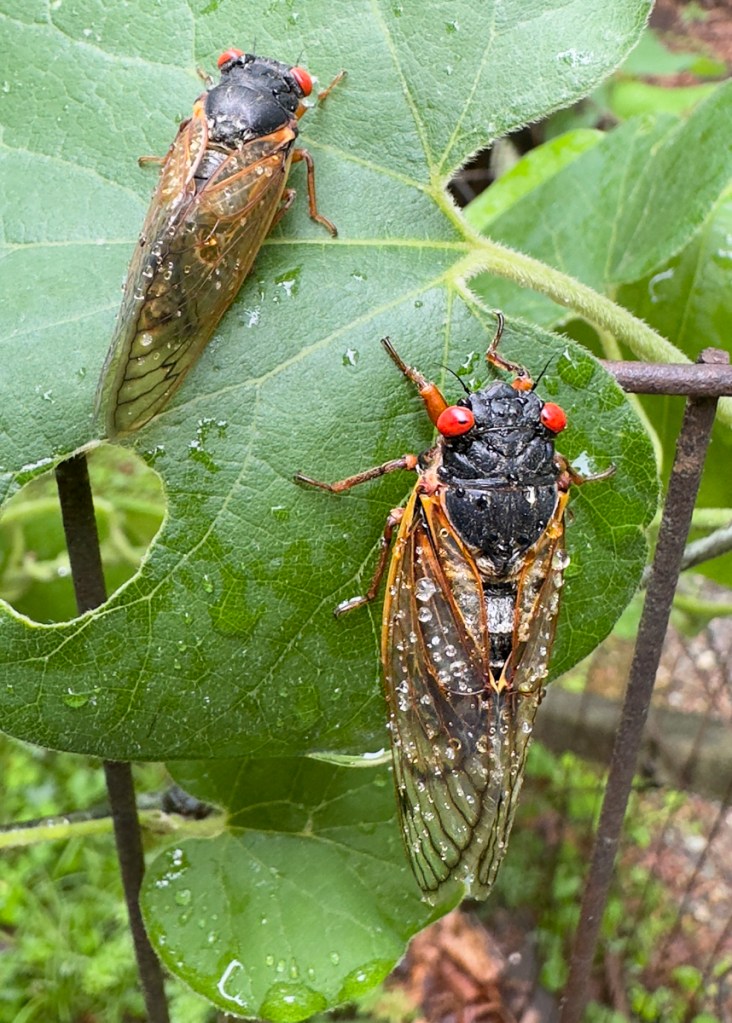
Looking at the timing in my photos from 2011, mating should be occurring this week with egg-laying by the week after. They will start dying shortly after that and hatchlings should drop out of the trees by late June. We will then need to be patient, as we won’t see them again until 2037! Hope i’m still around to enjoy the spectacle.


Great post! Here in CH ( Near Carolina North) we’ve had hundreds in our yard for the past 2 weeks or so. Maybe with your encouragement I’ll eat one. (I’ve sampled grasshoppers in Mexico and termites in Kenya😉).
Thanks, Sherry. I just found one with the fungus on the rear of its abdomen, so now I may be rethinking my eating habits:) More on that fungus in a new note later.
Thanks Mike – great info on the cicadas. I was just talking to a friend about whether there’s more than 1 species of the 13 year cicadea, and up pops your answer!
Thanks, Elaine. It is a fascinating event for sure.
Thanks for this excellent description, Mike. When I first heard the chorusing, I thought it was traffic noise!
Thanks, Ginger. I am still seeing a lot of posts on Next Door, etc., where people are wondering what that sound is.
So detailed, so timely, so wonderful. Thanks, Genie
Thank you, Genie.
This is just the best I’ve read. I love having the wing pictures side by side comparing before and after plus the description. Thank you so much. Lynn.
Thanks, Lynn.
Pingback: Cicada Post Addendum | Roads End Naturalist
Great photos and explanaron, Mike! I love seeing the progression from nymph to fully pigmented, winged adult. I haven’t seen any here in Greensboro but saw several at Kathryn’s house in Durham 10 days ago.
Thanks, Ann. It has been quite a show here. The rain has dulled the chorusing a bit but I imagine they will crank back up on the next sunny day (although they may not be singing that much longer).